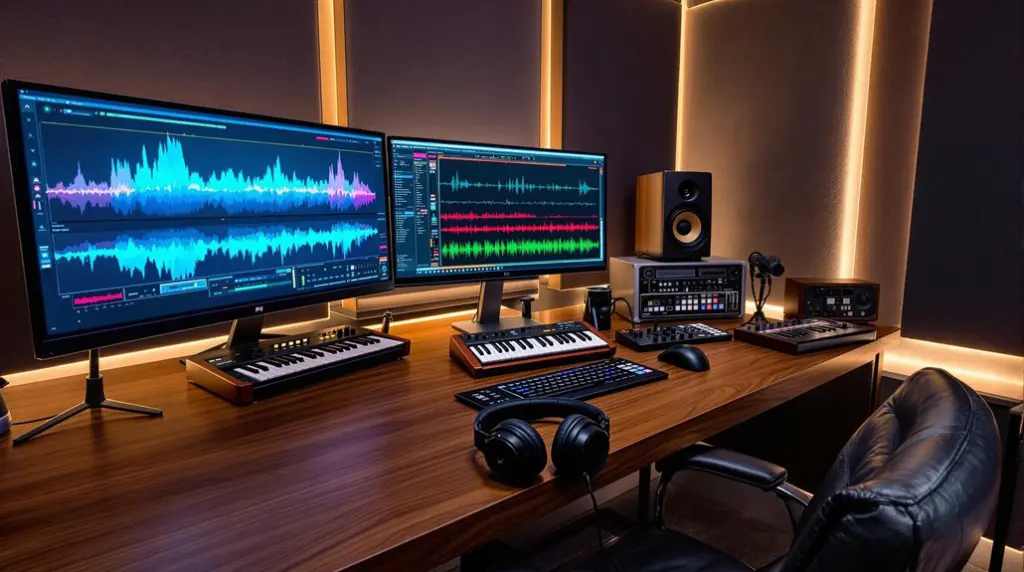Spring reverb operates as a mechanical audio effect that emulates natural reverberation by utilizing the vibration of metal springs. The process begins when an input transducer converts electrical audio signals into mechanical vibrations, which then initiate resonance in the springs. The springs’ physical properties, including length and tension, influence the resulting echoes. An output transducer captures these vibrations, converting them back into electrical signals. This method produces a distinctive metallic tone and quick decay, setting it apart from other reverb types. Understanding its nuances can enhance audio applications, inviting further exploration into its functionalities and uses.
Key Takeaways
- Spring reverb converts electrical audio signals into mechanical vibrations through an input transducer, initiating the reverb effect.
- Metal springs in the reverb tank vibrate, creating echoes influenced by their length, thickness, and tension.
- An output transducer captures the mechanical oscillations and converts them back into electrical signals for amplification.
- The unique metallic tone and quick decay of spring reverb differentiate it from other types of reverb.
- Proper setup and configuration enhance performance, optimizing the reverb effect and sound quality in various applications.
Understanding Spring Reverb
Spring reverb, a mechanical audio effect, operates through a system of metal springs designed to emulate the natural reverberation found in various spaces.
Within a spring reverb unit, an input transducer converts an electrical audio signal into mechanical vibrations, which propagate through the springs. These mechanical oscillations create a reverb effect characterized by distinct echoes, influenced by the springs’ length, tension, and material composition.
The output transducer subsequently captures these oscillations, converting them back into an electrical signal. This process allows the mixed reverberated sound to blend seamlessly with the original audio signal.
Known for its unique tinny, metallic tone, spring reverb enhances electric guitar tones, adds texture to snare drums, and imparts grit to rock vocals, enriching the auditory experience. Additionally, spring reverb is often utilized in guitar amplifiers to achieve an ethereal effect that complements various music genres.
Historical Context
Developed in the early 20th century, spring reverb technology emerged from innovations at Bell Labs, where the concept of mechanical reverberation was first explored.
Laurens Hammond was the first to musically utilize spring reverbs in 1939 with Hammond Organs, aiming to replicate church acoustics in domestic environments.
The technology gained momentum in the 1960s, particularly with the introduction of the Accutronics Type 4 spring reverb, designed for guitar amplifiers.
This unit became a cornerstone in rock music, as Leo Fender licensed the technology for his Twin Reverb and Vibroverb amplifiers.
The distinctive output signal produced by spring reverbs greatly influenced genres such as rock, blues, surf rock, and reggae, solidifying their role in popular music history.
Mechanism of Action
The operation of spring reverb hinges on the interaction between mechanical vibrations and electronic signals. It begins with an input transducer that converts an electrical signal into mechanical vibrations, causing the springs within the reverb tank to vibrate.
These oscillations generate multiple echoes, simulating the natural reverberation found in acoustic environments. The characteristics of the reverb, including length, thickness, and tension of the springs, influence the resulting sound.
Subsequently, an output transducer captures the mechanical oscillations and transforms them back into an electrical audio signal. This process effectively blends the reverb effect with the original sound, resulting in a unique auditory experience, especially distinct from other reverb types such as plate or hall reverb, primarily due to its tinny, metallic tone.
Sound Characteristics
Spring reverb is distinguished by its metallic echo effect, which enhances high frequencies and contributes to a pronounced sense of space within a mix.
The unique tonal qualities arise from the mechanical properties of the springs, including their length and tension, allowing for a range of auditory experiences that can vary considerably based on configuration.
These characteristics make spring reverb a preferred choice for genres seeking distinct textures and a vintage aesthetic.
Metallic Echo Effect
Metallic echoes produced by spring reverb are characterized by a distinct, tinny resonance that sets them apart from natural reverberation.
The unique metallic echo effect arises from the vibrations of metal springs, yielding a quick burst of high frequencies followed by mid-range echoes. This sonic quality makes spring reverb particularly suitable for rock and surf music, where its edgy and artificial sound enhances the character of electric guitar tones and vocals.
The decay times of spring reverb typically range from 2.75 to 4.0 seconds, allowing for significant depth and atmosphere in mixes.
Factors such as spring length, tension, and material composition directly influence the tonal characteristics of the echoed sound, reinforcing the distinctiveness of this reverb style.
Unique Tonal Qualities
Characterized by a distinct metallic tone, spring reverb produces a sound that is both edgy and unique, marked by a quick burst of high frequencies followed by mid-range echoes.
The tonal characteristics of a spring unit are influenced by the springs’ length, tension, and material, with shorter springs delivering tighter decay times and longer springs providing spacious reverberation.
This reverb sound often exhibits a tinny and bright quality, effectively enhancing electric guitar tones to cut through dense mixes.
Additionally, spring reverb’s ability to generate significant feedback contributes to its distinct texture, making it an invaluable tool for adding depth and clarity to various instruments, particularly snare drums and vocals, while imparting a lo-fi, vintage vibe suitable for genres like rock and surf music.
Practical Applications
Spring reverb serves critical functions across various musical applications, most significantly in enhancing the sound of electric guitars, which benefit from its distinct metallic echo.
Additionally, its capability to improve vocal texture is evident in rock music, where it helps vocals penetrate dense mixes.
The use of spring reverb on snare drums further exemplifies its versatility, particularly in genres like reggae and dub, where it accentuates rhythmic clarity. This type of reverb, characterized by its unique sonic characteristics, offers a distinct tonal quality that can transform a mix.
Enhancing Guitar Sound
When applied thoughtfully, reverb can greatly enhance the sound of electric guitars, adding depth and texture that is essential in various musical styles. The reverberation effect produced by a spring tank creates a distinctive metallic echo, elevating clarity in mixed environments.
| Application | Effect on Sound | Ideal Settings |
|---|---|---|
| Rhythm/Funk Guitar | Tight, focused sound | Mono, short decay times |
| Distorted Guitars | Vintage character, standout presence | Bright settings |
| Guitar Solos | Enhanced articulation without muddiness | Short decay, layered effects |
| Creative Expression | Unique soundscapes with modulation | Layering with delay |
Vocal Texture Improvement
To achieve significant improvements in vocal texture, the application of reverb can be instrumental, particularly when utilizing spring reverb‘s unique characteristics. This effect adds depth and brightness, allowing vocals to stand out prominently in mixes, especially within rock and pop genres.
The rapid decay time of spring reverb, typically ranging from 1.2 to 2.0 seconds, provides a natural yet pronounced effect that enhances vocal delivery. Employing a low-pass filter can effectively manage high-frequency response, preventing muddiness in complex arrangements.
Additionally, layering spring reverb with other effects like delay or EQ adjustments can yield distinctive vocal textures. Experimenting with mono applications can create a focused sound, while stereo settings enhance the overall spaciousness and depth, critical in audio engineering.
Snare Drum Applications
While various reverb types can enhance snare drum sounds, the unique characteristics of spring reverb offer distinct advantages in achieving clarity and brightness. Its quick decay times produce a sharp, metallic echo that complements the snare’s attack, making it ideal for genres such as reggae and dub. By incorporating spring reverb, engineers create a sense of space without overshadowing the fundamental snare sound, ensuring a pronounced hit in the output signal. Layering with equalization can further refine low-end frequencies, enhancing overall sound quality. Experimentation with settings is essential, as the spring reverb’s characteristics can markedly alter tonal qualities across diverse musical contexts.
| Effect | Characteristic | Application |
|---|---|---|
| Clarity | Bright, metallic echo | Snare drum enhancement |
| Space | Defined space perception | Genre-specific applications |
| Output signal | Pronounced snare hit | Mixing and mastering |
| Versatility | Unique tonal shaping | Diverse musical contexts |
Setup and Configuration
Setting up a spring reverb unit requires careful attention to both electrical connections and physical placement to guarantee peak performance.
Begin by connecting the input transducer to the audio source, ensuring that the input impedance aligns with the specifications of the spring tank—typically 8 Ohms for Accutronics units. The output transducer should be linked to the amplifier or mixer, adhering to an output impedance of 2250 Ohms.
For installations exceeding 10 meters, utilize longer jack to RCA cables to prevent signal loss.
Mount the spring tank vertically with connectors facing upward to optimize transducer alignment and minimize mechanical feedback. Additionally, position output connectors away from power sources to mitigate electrical interference, and regularly check mounting integrity using grommets or rubber standoffs.
Comparison With Other Reverb Types
Understanding the nuances between spring reverb and other reverb types is essential for audio professionals seeking to achieve specific sound characteristics. Spring reverb, known for its metallic, tinny sound and quick frequency response, excels in genres like rock and surf. In contrast, digital reverb aims to replicate natural spaces but often lacks the distinctive character of spring reverb. Plate reverb offers a smoother tone, while hall reverb provides a denser sense of space. The following table summarizes the key differences:
| Reverb Type | Characteristics |
|---|---|
| Spring Reverb | Metallic, quick decay, lo-fi quality |
| Digital Reverb | Emulates spaces, less unique character |
| Hall Reverb | Dense, rich reverb, large acoustic simulation |
Additionally, spring reverb’s non-linear response contributes to its unique sound, making it a popular choice for adding gritty texture to recordings. Each type contributes uniquely to the sounding reverb environment.
Frequently Asked Questions
How Does the Spring Reverb Work?
The spring reverb design utilizes analog reverb circuits to create distinctive echoes through mechanical vibrations. Understanding reverb settings tips enhances sound manipulation techniques, optimizing musical applications and achieving desired auditory effects within various genres and contexts.
How Does a Spring Reverb Work in Physics?
Spring reverb operates through spring dynamics, where sound waves induce mechanical vibrations. The acoustic properties of the springs facilitate resonance effects, effectively shaping the audio signal in audio engineering to replicate natural reverberation characteristics.
What Is the Difference Between Spring Reverb and Plate Reverb?
The differences between spring reverb and plate reverb lie in their applications and sound quality. Spring reverb, characterized by compact reverb circuit design, enhances gritty tones, whereas plate reverb offers lush characteristics, rooted in historical reverb technology.
What Is the Difference Between 2 Spring and 3 Spring Reverb?
The difference between two spring and three spring reverb types lies in their reverb sound characteristics and applications. Three spring technology offers smoother decay and refined feedback, while two spring units provide a grittier, vintage reverb history suitable for specific genres.
Conclusion
To conclude, spring reverb operates through mechanical vibrations transmitted via metal springs, producing a distinct auditory effect characterized by a rich, resonant quality. Its historical significance and unique sound characteristics render it a staple in both recording and live sound environments. Practical applications continue to evolve, showcasing versatility across various musical genres. When compared to other reverb types, spring reverb maintains a unique identity, offering an organic warmth that remains highly sought after in audio production.




